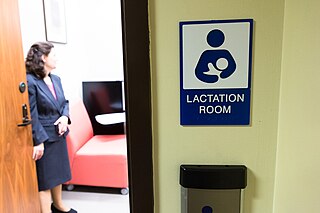
Infant formula, baby formula or just formula or baby milk, infant milk or first milk, is a manufactured food designed and marketed for feeding to babies and infants under 12 months of age, usually prepared for bottle-feeding or cup-feeding from powder or liquid. The U.S. Federal Food, Drug, and Cosmetic Act (FFDCA) defines infant formula as "a food which purports to be or is represented for special dietary use solely as a food for infants by reason of its simulation of human milk or its suitability as a complete or partial substitute for human milk".

A breast pump is a mechanical device that lactating women use to extract milk from their breasts. They may be manual devices powered by hand or foot movements or electrical devices powered by batteries or electricity from the grid. Breast pumps, like lactation rooms, are most common in the United States.

Breast milk is the milk produced by the breasts of a human female to feed a child. Milk is the primary source of nutrition for newborns before they are able to eat and digest other foods; older infants and toddlers may continue to be breastfed, in combination with other foods from six months of age when solid foods should be introduced.

Breast engorgement occurs in the mammary glands due to expansion and pressure exerted by the synthesis and storage of breast milk. It is also a main factor in altering the ability of the infant to latch-on. Engorgement changes the shape and curvature of the nipple region by making the breast inflexible, flat, hard, and swollen. The nipples on an engorged breast are flat or inverted. Sometimes it may lead to striae on nipples, mainly a preceding symptom of septation mastitis.

A galactagogue, or galactogogue, is a substance that promotes lactation in humans and other animals. It may be synthetic, plant-derived, or endogenous. They may be used to treat low milk supply.

Lactational amenorrhea is the temporary postnatal infertility that occurs when a woman is amenorrheic and fully breastfeeding.

A nipple shield is a nipple-shaped sheath worn over the areola and nipple during breastfeeding. Modern nipple shields are made of soft, thin, flexible silicone and have holes at the end of the nipple section to allow the breast milk to pass through.

Erotic lactation is sexual arousal by breastfeeding on a woman's breast. Depending on the context, the practice can also be referred to as adult suckling, adult nursing, and adult breastfeeding. Practitioners sometimes refer to themselves as being in an adult nursing relationship (ANR). Two persons in an exclusive relationship can be called a nursing couple.

Lactation room is an American English term for a private space where a nursing mother can use a breast pump. The development is mostly confined to the United States, which is unique among developed countries in providing minimal maternity leave. Historian Jill Lepore argues that the "non-bathroom lactation room" and breast pumps generally are driven by corporate need for workers rather than mothers' wishes or babies' needs.

Lactation describes the secretion of milk from the mammary glands and the period of time that a mother lactates to feed her young. The process can occur with all post-pregnancy female mammals, although it predates mammals. In humans the process of feeding milk is also called breastfeeding or nursing. Newborn infants often produce some milk from their own breast tissue, known colloquially as witch's milk.

A human milk bank or breast milk bank is a service which collects, screens, processes, and dispenses by prescription human milk donated by nursing mothers who are not biologically related to the recipient infant. The optimum nutrition for newborn infants is breastfeeding, if possible, for the first year. Human milk banks offer a solution to the mothers that cannot supply their own breast milk to their child, for reasons such as a baby being at risk of getting diseases and infections from a mother with certain diseases, or when a child is hospitalized at birth due to very low birth weight, and the mother cannot provide her own milk during the extended stay for reasons such as living far from the hospital.

Breastfeeding promotion refers to coordinated activities and policies to promote health among women, newborns and infants through breastfeeding.
Dysphoric milk ejection reflex (D-MER) is an anomaly of the milk release mechanism in lactating women. A lactating woman who has D-MER experiences a brief dysphoria just prior to the milk ejection reflex.

Diana West is a leading lactation consultant and author specializing on the topic of breastfeeding.

A lactation consultant is a health professional who specializes in the clinical management of breastfeeding. The International Board of Lactation Consultant Examiners (IBLCE) certifies lactation consultants who meet its criteria and have passed its exam.

A prolactin modulator is a drug which modulates the secretion of the pituitary hormone prolactin from the anterior pituitary gland. Prolactin inhibitors suppress and prolactin releasers induce the secretion of prolactin, respectively.

In computing, a Digital Object Identifier or DOI is a persistent identifier or handle used to identify objects uniquely, standardized by the International Organization for Standardization (ISO). An implementation of the Handle System, DOIs are in wide use mainly to identify academic, professional, and government information, such as journal articles, research reports and data sets, and official publications though they also have been used to identify other types of information resources, such as commercial videos.

The International Standard Book Number (ISBN) is a numeric commercial book identifier which is intended to be unique. Publishers purchase ISBNs from an affiliate of the International ISBN Agency.
















